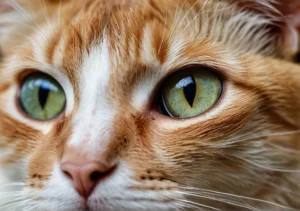Cats with blue eyes are captivating creatures that often leave us in awe. Have you ever wondered why some cats possess these mesmerizing blue eyes? The answer lies in their genetics, giving them a unique and striking appearance.
Genetic Explanation
Have you ever wondered why some cats have mesmerizing blue eyes while others don’t? Well, genetics hold the key to unlocking this mystery. Genes play a crucial role in determining a cat’s eye color, including the specific ones responsible for that stunning blue hue. It all comes down to a gene called OCA2, which is known to influence the production of melanin in the eyes.
In cats with blue eyes, there is a reduced amount of melanin present in the iris, which allows light to scatter and reflect off the structure of the eye, resulting in that striking blue color. This genetic variation is more common in certain breeds like Siamese and Ragdoll cats, which are known for their piercing blue eyes. So, the next time you gaze into a pair of beautiful blue feline eyes, remember, it’s all in the genes!
Evolution of Blue Eyes
Now, let’s delve into the fascinating world of evolutionary biology and explore why some cats have developed blue eyes over time. Blue eyes in cats are thought to have evolved as a result of selective breeding practices. Back in the day, humans unknowingly favored cats with this unique eye color, leading to its prevalence in certain breeds.
But here’s an interesting fact: the blue coloration of a cat’s eyes is not just for aesthetics. It actually serves a purpose in low light conditions by allowing more light to enter the eye and improve vision. This could have been a beneficial trait for cats hunting at dawn or dusk, giving them an evolutionary advantage in catching their prey.
So, the next time you admire a cat with blue eyes, remember that it’s not just a beautiful quirk of nature, but a trait shaped by millions of years of evolutionary history.
Health Implications
Blue eyes in cats are often linked to a lack of melanin in the iris, which can sometimes indicate potential health issues. Blue-eyed cats, especially those with a predominantly white coat, are more prone to vision problems such as sensitivity to light or even deafness. It’s crucial to regularly monitor your blue-eyed feline’s eyes for any signs of irritation, redness, or discharge, as these could be indicators of underlying health issues.
To properly care for your blue-eyed cat’s eyes, gently wipe them with a damp cloth to remove any debris or dirt that may accumulate. Make sure to schedule regular check-ups with your veterinarian to monitor your cat’s overall eye health and address any concerns promptly. Providing a balanced diet rich in essential nutrients like Vitamin A can also support your cat’s eye health and overall well-being. Remember, good eye care is essential to keeping your furry friend healthy and happy!
Rare Breeds
Certain cat breeds are more likely to have striking blue eyes, adding a touch of uniqueness to their appearance. Breeds such as Siamese, Ragdoll, Turkish Van, and Balinese are known for their captivating blue eyes, which enhance their charm and elegance. These rare felines have been captivating cat lovers for generations with their mesmerizing gaze and distinctive personalities.
The history and characteristics of these rare breeds further add to their allure. Siamese cats, for example, are known for their vocal nature and sleek bodies, while Ragdolls are famous for their affectionate and relaxed demeanor. Turkish Vans are prized for their love of water and playful personalities, making them a delightful addition to any family. Embrace the beauty and uniqueness of these rare blue-eyed breeds, and enjoy the special bond they bring into your life.
Additional Unique Insight: When selecting a cat breed with blue eyes, consider the level of maintenance required for their care. Some blue-eyed breeds may have specific grooming needs or dietary preferences that are essential to their well-being. Researching and understanding the characteristics of each rare breed can help you provide the best care for your beloved feline companion.
Cat Eye Anatomy
Have you ever wondered why cats have blue eyes? Well, the answer lies in their fascinating anatomy. A cat’s eye contains specialized cells called melanocytes that produce melanin, which is responsible for the color of their eyes. In the case of blue eyes, there is a low concentration of melanin in the iris, giving it a blue hue. This lack of melanin allows light to scatter and reflect off the back of the eye, creating the mesmerizing blue color that we see.
Myths vs. Facts
When it comes to cats with blue eyes, there are several myths and misconceptions floating around. One common myth is that all white cats with blue eyes are deaf, but this is not always the case. While there is a higher prevalence of deafness in white cats with blue eyes, not all of them are deaf. Another myth is that all cats with blue eyes are purebred, which is also false. Cats of any breed can have blue eyes, regardless of their pedigree.
- Blue-eyed cats are not always deaf.
- Blue eyes do not necessarily indicate a purebred cat.
- Blue-eyed cats are not more aggressive than cats with other eye colors.
Remember, not everything you hear about cats with blue eyes is true. It’s essential to separate fact from fiction when it comes to feline eye colors.
Changing Eye Color
Have you ever noticed a cat’s eye color change over time? It’s not just your imagination! Cat eye color can actually change as they grow older. Factors such as genetics, age, and health can all play a role in this intriguing process. Kittens are typically born with blue eyes, which may later change to green, yellow, or even orange as they mature. This change in eye color is due to the development of pigment in the iris as cats age. So, don’t be surprised if your cat’s eyes look different now compared to when they were a kitten!
Cat Eye Colors
When it comes to cat eye colors, blue eyes are quite captivating. While blue eyes are less common in adult cats, they can be found in certain breeds like the Siamese or Ragdoll. Blue eyes in cats are the result of a lack of pigment in the iris, allowing light to scatter and create a striking blue hue. Other common eye colors in cats include green, yellow, and copper. Each eye color offers a unique and beautiful look to different feline populations.
- Green Eyes: Green eyes in cats are the result of a combination of yellow and blue pigments in the iris, creating a stunning emerald color.
- Yellow Eyes: Yellow eyes are often associated with wild cat breeds and can range from pale yellow to deep gold, adding a fierce look to a cat’s appearance.
- Copper Eyes: Copper eyes are a variation of orange and yellow tones, offering a warm and inviting gaze to certain cat breeds.
Remember, a cat’s eye color is not only a matter of genetics but can also be influenced by age, health, and even mood. So, take some time to appreciate the unique beauty of your feline friend’s eyes, no matter what color they may be!
Fun Facts
Did you know that blue-eyed cats are not a specific breed, but rather a genetic variation found in many different cat breeds? This unique eye color comes from a lack of melanin in the iris, allowing the blue color to show through. While some cat breeds are more commonly associated with blue eyes, such as the Siamese or Ragdoll, any cat can potentially be born with striking blue eyes.
Blue-eyed cats are often considered to have a mystical or enchanting quality, which adds to their allure. They are sometimes believed to possess special powers or supernatural abilities in various cultures and folklore. This mystique surrounding cats with blue eyes has made them highly sought after and prized by many cat enthusiasts.
If you’re lucky enough to have a cat with blue eyes in your life, cherish their unique beauty and enjoy the mesmerizing gaze that can captivate your heart. Whether they are purebred or mixed breed, cats with blue eyes are sure to stand out and capture the attention of everyone they meet.
Did You Know?
- Blue-Eyed Gene: The gene responsible for blue eyes in cats is a recessive gene, meaning both parents must carry the gene for a kitten to be born with blue eyes.
- Changing Eye Color: Some blue-eyed cats may have their eye color change over time, especially as kittens grow into adulthood.
Alex, a passionate animal lover, has experience in training and understanding animal behavior. As a proud pet parent to two dogs and three cats, he founded AnimalReport.net to share insights from animal experts and expand his knowledge of the animal kingdom.




